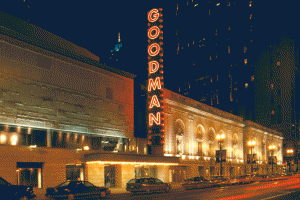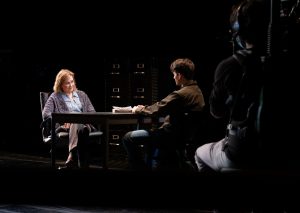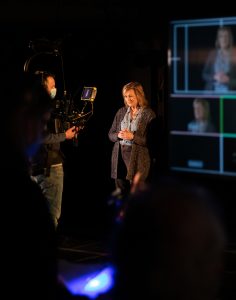
 Highly Recommended! *****Based on a powerful script by Adam Rapp and immaculately directed by Robert Falls, “The Sound Inside” is a flawlessly original two-character play that poses more questions than it answers… and does so in a splendid way! This is an intense, spellbinding story about the intersection of the lives of a middle-aged English professor and her star pupil. Their dialogue points up the existentialism in their lives… and in ours. Our future is the ellipsis at the end of someone else’s novel…. But who is that “someone else?” And who are we? And what exactly has been omitted—or has not yet been written—in the book that tells our life story?
Highly Recommended! *****Based on a powerful script by Adam Rapp and immaculately directed by Robert Falls, “The Sound Inside” is a flawlessly original two-character play that poses more questions than it answers… and does so in a splendid way! This is an intense, spellbinding story about the intersection of the lives of a middle-aged English professor and her star pupil. Their dialogue points up the existentialism in their lives… and in ours. Our future is the ellipsis at the end of someone else’s novel…. But who is that “someone else?” And who are we? And what exactly has been omitted—or has not yet been written—in the book that tells our life story?
When professor and novelist Bella Baird (Mary Beth Fisher) narrates her inner world, she points to things that a person doesn’t normally tell anyone, except possibly a close confidante. All throughout, Bella tells us in intimate and elaborate detail who she is and what she’s thinking and doing. Her descriptive monologues never bore the audience; rather, they fascinate and enlighten us. Above all, Bella loves great literature. Though sheer determination and hard work, she has landed a plum job at Yale University and teaches an English class on authorship, namely, how to write plausible, effective, and deep fiction. One of the main points that she makes in her class is to let the characters go and have them write the story for themselves. When Christopher Dunn (John Drea) unexpectedly shows up to her office and tells her that she has inspired him to write his own novel, the question that Bella finds herself asking is this: How much of himself is in his protagonist, and how much is his protagonist in him?
Dunn is the odd combination of the old and the new. He scorns modern technology but has learned to live with it. He hates email and prefers pen and paper, but above all, he and Bella share lots of literary references. Watching this show made me feel as if I had gone back in time and had suddenly become a student in Bella’s classroom. I happened to have read half the books that were being mentioned at an earlier time in my life, and in the midst of the performance, I was busy trying to recall the various plots and characters. All that being said, the play operates on many different levels, and having some grasp on what each of these books is about is not essential to understanding the plot (although it can enhance our experience). All the audience really needs to know that Bella and Christopher together explore the meaning of murder in Fyodor Dostoyevsky’s Crime and Punishment, while Bella’s apparent favorite book is “Light Years” by James Salter, and Christopher favors “Old Yeller” by Fred Gipson. (Note that the online program contains a brief description of all the famous literature alluded to throughout the show.) But the bottom line is that each of these novels merge into one epiphany that can best be stated as two questions: What responsibility do we have to each other in preserving or taking somebody else’s life—or our own? And do we lose something of ourselves when confronted by the death, disability, and suffering of others?
The acting in this show was superb. There are not enough superlatives to describe how enjoyable a performance it was. The only issue I had with the production was technical. Using three or four hand-held cameras with Steadicams (rather than the much heavier and bulkier studio cameras) created just a bit too much shakiness during the medium and close-up shots of the actors . The slight jiggle was not horrible enough to be super-distracting but didn’t suit a storyline which is supposed to be quiet and introspective. Yet the use of studio cameras would not have provided the freedom and flexibility necessary to capture a lot of the camera angles. All that being said, I liked the work of video director Christiana Tye and director of photography Gabe Hatfield, because it was super-creative, especially the 360-degree design of the camerawork relative to the stage. I loved the way the cameras followed the evolution of one set into another. The switching was fantastic and seamless and not easy work during a live performance.
Timing all the lighting and highlighting to match the movements of the Steadicams is quite a feat. Kudos must go to lighting director Jason Lynch, who positioned the proper lighting for the recorded video. Switching gears from “ordinary” theatrical lighting to that suitable for video is an art. Set design by Arnel Sancianco worked exceedingly well, such that the sets were detailed enough so that the audience understood the surroundings, yet minimal enough to provide chumminess, allowing the focus to always remain on the two main characters. The original music and sound design by Richard Woodbury and the costume design by Mieka van der Ploeg were perfect to tell this tale. Note that the remote technology is excellent. The online viewer can pause the live videostream and pick it up shortly afterwards; and we can watch the newly recorded version without a hitch. However, you will need Google Chrome or Safari as your web browser for optimal viewing.
How can we, in the process of living our lives, come to realize the engine that drives the story of why we are here, where we are going, and where we have been and why? Do any of us have the power to change the story’s ending—or even know what that ending is supposed to be? To discover all this, the true author is supposed to tap into what Bella calls the “sound inside”: some form of stream of consciousness that extracts one’s deep feelings and emotions and provides some means of release. But is this sound inside of us authentic or deceptive or simply not all-knowing? How much involvement do each of us have as characters in writing our own script, or is this beyond our control? Perhaps it is living in the junction of the known and the unknown and the unknowable that allows us to be fully present at this given moment in time… watching this superior presentation… and contemplating just what the ellipsis means.
“The Sound Inside” was a live performance at the studio theater of the Goodman Theatre that was simultaneously videocast for the purpose of being watched by a remote audience. It was available on their new Live Series, three productions streaming in real time. Each play runs for only one week.
With five performances having already taken place in May, “The Sound Inside” has already closed.
 For more information about the Live Series and the two remaining shows that are being livestreamed in June and July, please go to: https://www.goodmantheatre.org/Live.
For more information about the Live Series and the two remaining shows that are being livestreamed in June and July, please go to: https://www.goodmantheatre.org/Live.
Individual tickets are $30. A Live Membership is $60.
For more information on purchasing tickets, contributing to the Goodman Theatre, or learning about future shows, please go to: https://www.goodmantheatre.org/.
Perhaps they can bring this to the live studio theater once the theaters are back.
To see what others said, visit www.theatreinchicago.com, go to Review Round-Up and click at “The Sound Inside”.






More Stories
“Henry Johnson”
“Scary Town” reviewed by Frank Meccia
“Translations”